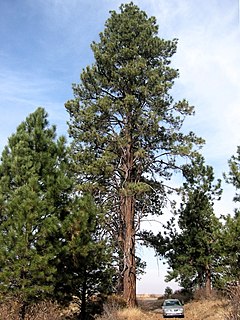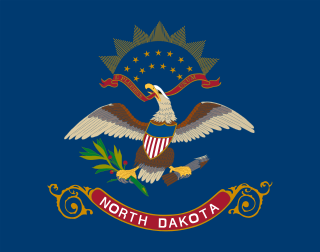
Lostwood Wilderness is a wilderness area located in the U.S. state of North Dakota. Created by an act of Congress in 1975, the wilderness covers an area of 5,577 acres (22.56 km2). Contained within Lostwood National Wildlife Refuge, the wilderness is managed by the U.S. Fish and Wildlife Service.

The Klamath Basin National Wildlife Refuge Complex is a wildlife preserve operated by the United States Fish and Wildlife Service in the Klamath Basin of southern Oregon and northern California near Klamath Falls, Oregon. It consists of Bear Valley, Klamath Marsh and Upper Klamath National Wildlife Refuge (NWR) in southern Oregon and Lower Klamath, Tule Lake, and Clear Lake NWR in northern California.

Lake Andes Wetland Management District is located in the U.S. state of South Dakota and includes 82,731 acres (334 km2). The refuge is managed by the U.S. Fish and Wildlife Service. Of the land area in the district, the U.S. Government owns only 19,177 acres (77.6 km2), while the remaining area is managed as an easement to help protect Waterfowl Production Areas from future development. The district oversees numerous wetland zones in an effort to ensure species protection. During Spring and Fall migration periods, tens of thousands of migratory birds can be found here, representing over 100 different species. The district is a part of the Lake Andes National Wildlife Refuge Complex. Bald eagles, northern pintail, mallards, snow geese, great grey owl, American kestrel, red-tailed hawk and prairie chicken are some of the more impressive bird species that can be found in the district.

Sand Lake Wetland Management District is located in the U.S. state of South Dakota and is administered by the U.S. Fish and Wildlife Service. This is the largest Wetland Management District in the U.S., with 45,000 acres (182 km2) of area directly under federal protection and another 550,000 acres (2,225 km2) managed in partnership with private landowners as conservation easements. A total of 162 Waterfowl Production areas are located on the federally owned lands and the conservation easements are generally adjacent to these areas and act as buffer zones to increase habitat protection.

Arrowwood National Wildlife Refuge is located in the U.S. state of North Dakota. Arrowwood NWR is a part of the Arrowwood National Wildlife Refuge Complex, and is managed by the U.S. Fish and Wildlife Service. The refuge parallels 16 miles (27 km) of the James River and is a mixture of wetlands, forest and prairie. Efforts to ensure the refuge continues to provide prime nesting habitat for waterfowl include prescribed fire, haying, crop cultivation and livestock grazing. The refuge has forests with oak and hackberry which are uncommon on the prairie. It is believed that the name for the refuge is derived from Native American naming for arrow wood, as the wood in the forest was prized for the making of arrows.

Arrowwood Wetland Management District is located in the U.S. state of North Dakota. Arrowwood WMD is a part of the Arrowwood National Wildlife Refuge Complex, and is managed by the U.S. Fish and Wildlife Service. The district consists of 28 Waterfowl Production Areas, 314 Wetland easements, one easement refuge known as Johnson Lake National Wildlife Refuge and another four easements through the Farmers Home Administration, altogether totalling 28,922 acres (117 km2).

Johnson Lake National Wildlife Refuge is located in the U.S. state of North Dakota. The Refuge was established by Executive Order 8122, signed on May 10, 1939 by President Franklin D. Roosevelt to be set aside as "a refuge and breeding grounds for migratory birds and other wildlife."

Chase Lake Wetland Management District is located in the U.S. state of North Dakota. The district is located in what is known as the prairie–potholes region of lakes and ponds, which were left behind by the retreat of glaciers at the end of the last ice age. Hundreds of waterfowl production areas, Wildlife Development Areas, wetland easements, grassland easements and the easement refuge known as Halfway Lake National Wildlife Refuge, are managed by the district. The district is a part of the Arrowwood National Wildlife Refuge Complex.

The Chase Lake Prairie Project is an effort to restore and protect the largest remaining region in the lower 48 states for waterfowl production. Located in U.S. state of North Dakota and consisting of 5,500,000 acres (22,000 km2) spread across 11 counties, this region is composed of thousands of lakes and ponds and grassland prairie. 97% of the land area is privately owned, with the U.S. Fish and Wildlife Service working with landowners to protect wetlands and associated prairie regions in a collaborative effort to ensure the region continues to provide habitat for the millions of birds and other wildlife that are dependent on the ecosystem.

The Halfway Lake National Wildlife Refuge is located in the U.S. state of North Dakota and consists of 160 acres (0.65 km2.) The refuge is a privately owned easement refuge, managed by the U.S. Fish and Wildlife Service. The refuge is closed to the public and was established to protect habitat for migratory bird species and other animal life. Chase Lake Wetland Management District oversees the refuge, which in turn is a part of the Arrowwood National Wildlife Refuge Complex.

The Valley City Wetland Management District is located in the U.S. state of North Dakota and consists of 76,000 acres (307 km2). The wetland district is a substation of the Arrowwood National Wildlife Refuge Complex, overseen by the U.S. Fish and Wildlife Service. 82 waterfowl production areas and four separate national wildlife refuges which are privately owned are in turn managed by the wetland district as easement refuges. The wetland district is in portions of 5 counties in the Prairie Pothole Region that was created by the retreat of glaciers 12,000 years ago, during the last glacial maximum. One third of the protected lands are wetlands with the balance consisting of prairie.

The Sibley Lake National Wildlife Refuge is located in the U.S. state of North Dakota and consists of 1,077 acres (4.35 km2). Sibley Lake is a privately owned easement refuge, managed with by the U.S. Fish and Wildlife Service. The refuge was established to protect habitat for migratory bird species, white-tail deer and other mammals. Valley City Wetland Management District oversees the refuge, which in turn is a part of the Arrowwood National Wildlife Refuge Complex. Sibley Lake is a 525-acre (2.12 km2) fresh water marsh.

The Tomahawk National Wildlife Refuge is located in the U.S. state of North Dakota and consists of 440 acres (1.78 km2). Tomahawk NWR is a privately owned easement refuge, managed with by the U.S. Fish and Wildlife Service. The refuge was established to protect habitat for migratory bird species, white-tail deer and other mammals. Valley City Wetland Management District oversees the refuge, which in turn is a part of the Arrowwood National Wildlife Refuge Complex. The refuge can be accessed from North Dakota Highway 1, and is one mile (1.6 km) east of the town of Rogers, North Dakota.

Audubon Wetland Management District is located in the U.S. state of North Dakota and consists of 123 Waterfowl Production Areas (WPAs), 8 National Wildlife Refuges (NWRs), and numerous wetland and grassland easements and over 100 separate wetland areas set aside to preserve habitat for bird, plant and mammal species. These lands contain valuable wetland and grassland habitat for waterfowl and other migratory birds, and many other species of wildlife. Scattered throughout west central and southwestern North Dakota in McLean, Ward, and Sheridan Counties, the district is managed by the U.S. Fish and Wildlife Service and from Audubon National Wildlife Refuge. Hundreds of lakes and marshlands in this region provide critical habitat for migratory and nesting bird species.

Lake Ilo National Wildlife Refuge (NWR) is located in the U.S. state of North Dakota and is managed from Audubon National Wildlife Refuge by the U.S. Fish and Wildlife Service. The refuge consists of Lake Ilo, surrounding wetlands and some upland range, providing habitat for hundreds of species of birds, and numerous fish and mammal species. An average of over 16 inches (40 cm) of precipitation falls annually, supporting a prairie ecosystem.

The Crosby Wetland Management District is located in the U.S. state of North Dakota. The district is located in the extreme northwestern section of North Dakota, along the border with Canada and the state of Montana. Within the district is the Lake Zahl National Wildlife Refuge, 96 parcels of land owned by the U.S. Government which are managed as Waterfowl Production Areas, and several hundred easement refuges that are on privately owned land which are cooperatively managed by the landowners and the U.S. Fish and Wildlife Service.

Lake Zahl National Wildlife Refuge is a 3,823-acre (1,547 ha) National Wildlife Refuge in Williams County in the U.S. state of North Dakota. The refuge consists of Lake Zahl which provides habitat for many species of waterfowl and other species. It is managed by the Crosby Wetland Management District.
The San Luis National Wildlife Refuge Complex is located in the northern San Joaquin Valley, within Merced County and Stanislaus County of California. The complex, with four federal National Wildlife Refuges, is managed by the U.S Fish & Wildlife Service.
Devils Lake Wetland Management District is located in the heart of the Prairie Pothole Region of the United States. The District was established in 1962 to purchase and protect wetland habitat for migratory waterfowl and other wildlife in northeastern North Dakota. One of the primary objectives of Devils Lake Wetland Management District is to provide wetland and grassland habitat for waterfowl in the spring and summer for nesting and feeding. The other primary objective is to provide migration habitat for waterfowl in the spring and fall.

Located in south-central North Dakota, Kulm Wetland Management District was established in 1971. Located in the Prairie Pothole Region of North America, Kulm Wetland Management District provides breeding, nesting, and brood rearing areas for many species of waterfowl and other migratory birds. The District currently manages 201 waterfowl production areas that total 45,683 acres (184.87 km2), 3 national wildlife refuges that are easement refuges, and 120,000 acres (490 km2) of wetland and grassland easements. The District's headquarters is in Kulm, North Dakota.










